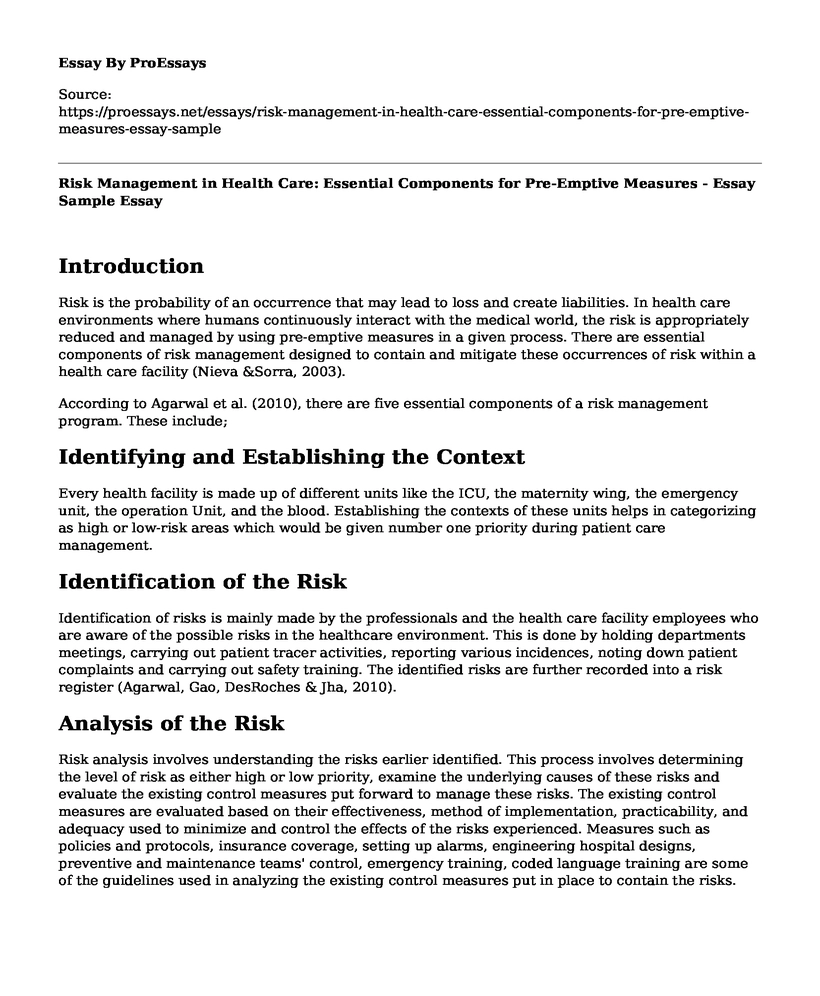Introduction
Risk is the probability of an occurrence that may lead to loss and create liabilities. In health care environments where humans continuously interact with the medical world, the risk is appropriately reduced and managed by using pre-emptive measures in a given process. There are essential components of risk management designed to contain and mitigate these occurrences of risk within a health care facility (Nieva &Sorra, 2003).
According to Agarwal et al. (2010), there are five essential components of a risk management program. These include;
Identifying and Establishing the Context
Every health facility is made up of different units like the ICU, the maternity wing, the emergency unit, the operation Unit, and the blood. Establishing the contexts of these units helps in categorizing as high or low-risk areas which would be given number one priority during patient care management.
Identification of the Risk
Identification of risks is mainly made by the professionals and the health care facility employees who are aware of the possible risks in the healthcare environment. This is done by holding departments meetings, carrying out patient tracer activities, reporting various incidences, noting down patient complaints and carrying out safety training. The identified risks are further recorded into a risk register (Agarwal, Gao, DesRoches & Jha, 2010).
Analysis of the Risk
Risk analysis involves understanding the risks earlier identified. This process involves determining the level of risk as either high or low priority, examine the underlying causes of these risks and evaluate the existing control measures put forward to manage these risks. The existing control measures are evaluated based on their effectiveness, method of implementation, practicability, and adequacy used to minimize and control the effects of the risks experienced. Measures such as policies and protocols, insurance coverage, setting up alarms, engineering hospital designs, preventive and maintenance teams' control, emergency training, coded language training are some of the guidelines used in analyzing the existing control measures put in place to contain the risks.
Evaluation of Risks
Evaluation of risks involves prioritizing the risk based on its severity and the results from risk analysis. This helps to determine if the risk is acceptable, treatable, and manageable. It generally determines the modes of treatment to be used to contain the risk. Accepting the risk does not necessarily mean that it is neglected, it could mean that the risk is probably too low and the modes of treatment are not readily available within the hospital facility.
Risk Management and Mitigation
Risk reduction, management, and treatment should be constant with the defined goals and objectives of the healthcare facility during management (Nieva &Sorra, 2003). The risk treatment plan usually involves the proposed actions for treatment, the available resources for the treatment, the involved parties for treatment and the timeframes it will take to complete the tasks and perform the treatment reviews. Controlling risk involves treating the risk to reduce any extensive adverse effects. However, the risk can be transferred to a third party on contractual basis especially when the risk is too broad and cannot be easily managed by the participating party. Monitoring and review of the risk are important in order to determine any residual risk and check for improvement after all the control measures applied during treatment. In conclusion, an effective risk management process is vital for every facility to promote efficiency and improved service delivery in management of risks. This helps to eliminate, contain and reduce the probability of reoccurrence of the risks involved.
References
Agarwal, R., Gao, G., DesRoches, C., & Jha, A. K. (2010). Research commentary-the digital transformation of healthcare: Current status and the road ahead. Information Systems Research, 21(4), 796-809. https://pdfs.semanticscholar.org/cf8b/96dabf484fc28049eebd3afc86e50bba45c8.pdf
Nieva, V. F., & Sorra, J. (2003). Safety culture assessment: a tool for improving patient safety in healthcare organizations. BMJ Quality & Safety, 12(suppl 2), ii17ii23.https://www.ncbi.nlm.nih.gov/pubmed/14645891
Cite this page
Risk Management in Health Care: Essential Components for Pre-Emptive Measures - Essay Sample. (2023, Feb 15). Retrieved from https://proessays.net/essays/risk-management-in-health-care-essential-components-for-pre-emptive-measures-essay-sample
If you are the original author of this essay and no longer wish to have it published on the ProEssays website, please click below to request its removal:
- Human Nutrition - Presentation Example on Public Health
- Carrefour Hypermarket Iraq Branch Essay
- Aging Black in America Essay Example
- The Well Being of the Elderly in Asia Versus Europe Essay
- Movie Analysis Essay on Jiro Dreams of Sushi
- Essay Sample on Chronic Sleep Disorders & Sleep Loss: A Global Public Health Crisis
- Essay Sample on School-Based Programs: Reducing Tooth Decay in Kids







